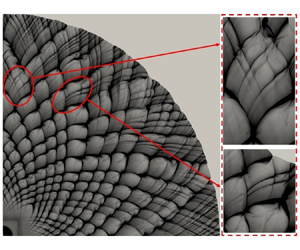Article contents
Direct detonation initiation in hydrogen/air mixture: effects of compositional gradient and hotspot condition
Published online by Cambridge University Press: 04 September 2023
Abstract

Two-dimensional simulations are conducted to investigate the direct initiation of cylindrical detonation in hydrogen/air mixtures with detailed chemistry. The effects of hotspot condition and mixture composition gradient on detonation initiation are studied. Different hotspot pressures and compositions are first considered in the uniform mixture. It is found that detonation initiation fails for low hotspot pressures and the critical regime dominates with high hotspot pressures. Detonation is directly initiated from the reactive hotspot, whilst it is ignited somewhere beyond the non-reactive hotspots. Two cell diverging patterns (i.e. abrupt and gradual) are identified and the detailed mechanisms are analysed. Moreover, cell coalescence occurs if many irregular cells are generated initially, which promotes the local cell growth. We also consider non-uniform detonable mixtures. The results show that the initiated detonation experiences self-sustaining propagation, highly unstable propagation and extinction in mixtures with a linearly decreasing equivalence ratio along the radial direction, i.e. 1 → 0.9, 1 → 0.5 and 1 → 0. Moreover, the hydrodynamic structure analysis shows that, for the self-sustaining detonations, the hydrodynamic thickness increases at the overdriven stage, decreases as the cells are generated and eventually becomes almost constant at the cell diverging stage, within which the sonic plane shows a ‘sawtooth’ pattern. However, in the detonation extinction cases, the hydrodynamic thickness continuously increases, and no ‘sawtooth’ sonic plane can be observed.
- Type
- JFM Papers
- Information
- Copyright
- © The Author(s), 2023. Published by Cambridge University Press
References
- 1
- Cited by





